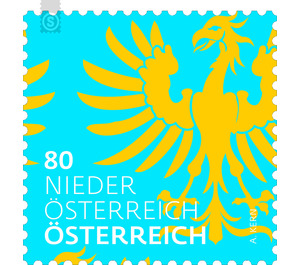coat of arms - Austria / II. Republic of Austria 2017 - 80 Euro Cent
Theme: Art & Culture
| Country | Austria / II. Republic of Austria |
| Issue Date | 2017 |
| Face Value | 80.00 |
| Perforation | 13½ x 13½ |
| Printing Type | offset |
| Stamp Type | Definitive |
| Item Type | Stamp |
| Chronological Issue Number | 2649 |
| Chronological Chapter | OOS-OE2 |
| SID | 760780 |
| Dimensions | 25.00 x 25.00 |
| In 49 Wishlists | |
The coats of arms of the nine Austrian provinces, which refer back to their origins back to the 12th century, when the heralds - dressed in the widely visible tabards - in the countless battles of the Middle Ages held the task of distinguishing friend and foe by coat of arms and flag, and to certify the outcome of the battle (Peter Diem). To represent these coats of arms 1: 1, as it was the case for example in the special stamp series of 1976, would no longer do justice to today's, modern Austria. The permanent stamp series "Heraldry Austria" shows the Austrian coat of arms in graphic processing. The designer of the series, Anita Kern, selected excerpts that allow unusual views and insights. As in close-up shots, the arms are "zoomed in" to make unknown details visible, while at the same time living up to the stamp format. This opens up a wealth of images and new perspectives. For example, on one of the 68-cent stamps in green you can see the red-eared Styrian Panther head, fire-spitting, or the red-ravaged black lion's paw of the Salzburg coat of arms on the 25 cent additional mark in gold (yellow in print). Whether it's the coat of arms or the Montforti banner of Vorarlberg, all of the coat of arms details appear in their powerful colors and shapes, mostly ornamental, sometimes geometric. The original shapes of the coat of arms elements have not been changed, the heraldic correct color, the "tinctures" and "metals" maintained. In the tint of the colors, however, the overall effect of the stamp was taken into account as a printing unit. The coats of arms, created in the feudal tradition of Europe, are strongly influenced by the Habsburg era and have historical and geographical features as well as religious motifs, such as the church flag of Montforter in Vorarlberg coat of arms. Basically, the coat of arms of the federal state goes back to those noble families who were rulers and feudal lords in the respective country - used by the emperor. After the collapse of the monarchy in 1918 - and again after 1945 - coats of arms were created or changed. Taking into account this cultural heritage, feudal visual characteristics such as imperial eagle, princely and duke's hats, ermine or knightly tournament helmets are still preserved in the Republic of Austria. However, these elements and the related contents are withdrawn by "zooming in," viewing through an imaginary magnifying glass. The names of the individual stamps are composed of the heraldic designations of the depicted coat of arms figures and the respective federal name. This designation helps the viewer to assign the excerpts to the entire coat of arms and simultaneously conveys heraldic vocabulary. The coat of arms of Lower Austria shows five golden eagles on a blue background. As ornament it carries a golden wall crown with three battlements. An eagle is depicted on this stamp.


